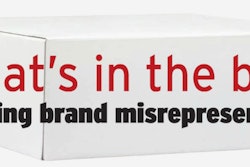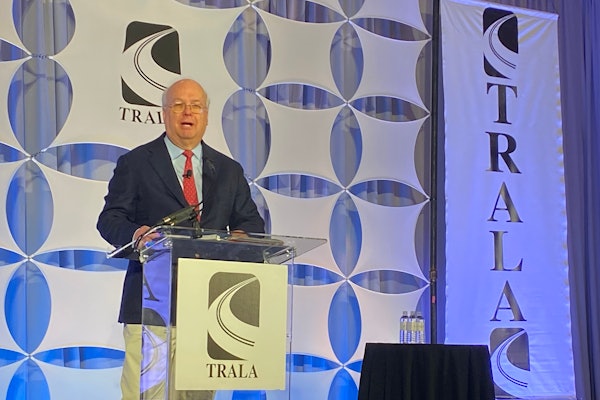The following comes from the April 2018 issue of Truck Parts & Service. To read a digital version of the magazine, please click the image below.

As customer acceptance of private label and white box products increases, brand-centric aftermarket distributors face extreme pressure to evolve.
Today’s independent heavy-duty aftermarket was founded on brands. For decades, aftermarket distributors built their companies from the ground up on the brands they sold. More often than not, these brands represented the best components available in the trucking industry — manufacturers with OEM first-fit positions, and names synonymous not only with the product categories they served but, in some cases, also invented.
For a long time, there was no better gauge of an independent distributor’s standing than a stacked supplier line card.
It appears those days are numbered.
While many distributors remain firmly committed to supporting and promoting the genuine brands they serve, the aftermarket customer is changing. A proliferation of new aftermarket suppliers and a rapid uptick in the availability of private labeled and offshore white box products have weakened brand loyalty across the industry. End user purchasing preferences are shifting, and while total cost of ownership remains a popular customer adage, when units are down, the draw toward lowest price has never been stronger.
The independent aftermarket, long viewed by its participants as the last bastion of the branded, genuine OE after-market part, has been disrupted. While the upheaval didn’t happen overnight — lower cost suppliers have been serving the aftermarket for as long as there’s been such an industry — the accelerated rate at which these unidentified, low-cost products are being released and accepted by end users has left distributors scrambling, urgently attempting to restructure their businesses to maintain gross margin and revenue totals around which they’ve built their businesses.
For an industry in flux, determining the next correct step is best undertaken by first understanding the previous one.
What forced this industry change?
There is a chicken-and-egg quality to the independent aftermarket’s brand erosion dilemma: Are customers deliberately pulling away from premium brands (and their higher margins for distributors) and seeking lower priced alternatives in a clear effort to cut costs; or have suppliers created such an abundance of price points that customers are subconsciously altering their longtime buying habits to capitalize on better prices?
“I think it’s a combination,” says Steven Prigal, president at All Roads Fleet Service & Supply. Prigal’s business, which recently rebranded after 60-plus years as The Brake Service Group, operates four locations in the New York City metropolitan area.
Across those facilities, Prigal says he is seeing more customers narrow in on individual unit price — “cost today, not the cost over the long term,” he says — when making purchasing decisions. However, he also acknowledges there are more new suppliers “attacking the industry at the low end” and forcing established aftermarket suppliers to respond.
“Some customers have always purchased on price,” adds Jay Boggeman, president at Plaza Fleet Parts. Boggeman says Plaza Fleet’s position as a brand house focused on premium aftermarket products has always somewhat insulated it from bargain shoppers, but there’s no question they’ve always been out there. “We’ve had some come through over the years, always looking for the cheapest price,” he says.
Yet it’s important to note that even with its focus on brands, it’s not as if the independent distribution channel has never catered to the price-conscious customer. The tradition of stocking A and B lines — A being a genuine OE replacement part and B an all-makes branded alternative — is nearly ubiquitous throughout distribution, and many distributors also have operated in-house machine shops to rebuild, repair and remanufacture specific components at lower, C-level price points. This structure worked for distributors because it offered enough choice for budget-conscious customers, but was still heavily tilted toward A lines and their value “over the long term.”
Not coincidentally, it is that same uneven scale that is now allowing so many new aftermarket suppliers, private labels and white box products to prosper. By entering the market at price points between the lower tiers and touting themselves as all-makes level equivalent, these lines have quickly become favorites for price-centric customers and have shown the ability to even draw in customers who were previously loyal to upper-tier branded parts.
On the chicken-and-egg conundrum, Fleet Brake President John Bzeta gives the supply chain the edge in implementing the aftermarket’s overhaul. He references the availability of new products at non-traditional distributors, such as truck stops, auto warehouse stores and online, as well as nationally available OEM private label brands, that enable dealers to sell extremely low-price value lines with the backing of a trusted truck maker’s brand.
“When a dealer is selling a product, right or wrong, a lot of customers view that product as an OE [genuine] item,” Bzeta says.
“We see that all the time,” adds Prigal. “A customer will see a part in a dealership and think if they’re selling it there, it’s the same” as what was installed on his vehicle. “That’s not always the case, but it’s so hard to teach them.”
Private labels have boomed for individual dealers and distributors as well.
“Looking specifically at friction, in the last 18 months we’ve seen [the market] go from five or six aftermarket offerings to well over a dozen. And a lot of that is the same product but different name brands,” says Michael Konrad, sales and marketing manager at Bremskerl.
There’s also the issue of how these new products force changes from premium brands. Sales erosion doesn’t only occur at the distributor level. Customers pulling away from genuine OE after-market products forces those manufacturers into a precarious position: Chase their volume losses with lower priced alternatives, or double down on the importance of quality and try to bring customers back.
Caught in the middle
While the independent aftermarket overwhelmingly prefers the latter, it has little say. The industry is tied to brands it cannot control. Its value proposition and business model are built on selling the performance, safety and customer support that comes with premium aftermarket brands.
Many distributors believe private label and white box lines lack the volume potential to neutralize the margin losses that come from abandoning top brands. Others question the go-to-market strategy, and how a business that positions itself as a premium supplier can undercut its own sales philosophy within the marketplace.
On that note, Boggeman adds, “We are not in the market to sell inferior product. We are not going to sell something we can’t stand behind.”
Boggeman’s statement also highlights another challenge distributors face when considering a deviation from branded inventory exclusivity. When a branded part fails, a distributor has a supplier’s support (through a warranty or cus-tomer service team) to fall back on. When a white box or distributor-sourced product fails, managing the customer’s circumstances is his and his alone.
“One thing we’ve noticed is when customers have concerns with a new part, if it’s a branded part, they’ll usually check around a little and see if something else is wrong. But with the white box stuff, when something goes wrong, they immediately blame the part,” Bzeta says.
He adds for some of Fleet Brake’s most popular part numbers the company has gone solely to genuine ‘A’ lines and “sales and margins increased, and warranty rates disappeared.”
John Locke says both margin and philosophical factors keep Point Spring & Driveshaft focused on the premium space. According to Locke, the company’s master purchaser, Point Spring’s guiding principle regarding its inventory always has been performance and end user satisfaction. The distributor wants to sell the best and wants its customers to rely on it for exactly that reason.
He acknowledges that approach has cost Point Spring some price hunters over the years — “we’ve walked away from some business, too,” he says — but in doing so also has ensured the company that the customers it has kept are loyal and value Point Spring for more than just a good price.
Says Locke, “Once you start dropping price, there’s always someone out there who’s willing to go lower.”
For what it’s worth, most brands in the heavy-duty aftermarket are well aware of the predicament facing their independent channel partners. The reputations and acclaim of many of the industry’s top brands were cultivated by the praises of their distributors.
“We spend a lot of time selling the value of genuine parts, focusing on lifecycle and how you pay more upfront but have less issues over time,” says Brian Cordle, business development manager at Haldex. “We cannot do that alone. We rely on our distributor partners to continue that education with our customers.”
Some suppliers also compliment independent distribution channel partners for their persuasive efforts with end users to recognize the importance of replacing like-for-like when maintaining safety system components.
“The thing I always try to talk about with our customers is that nobody ever tracks the near misses. Nobody ever tracks those situations where a driver misses an accident by five or 10 feet,” says Keith McComsey, director of marketing, customer solutions, wheel end at Bendix Spicer Foundation Brake. “But if you take that vehicle and you replace that driver’s friction material with a lower-level product, now that 10-ft. miss may very well become a statistic.
“I think distributors understand that,” he says. “That it’s hard to justify good, better, best when we’re talking about safety.”
“When [a customer] goes with the OE product, they know they are always going to get the product that provides the best possible results,” adds Daniel Beretta Piccoli, sales and marketing manager at Fras-le.
But because that is an option and not a requirement, manufacturers of genuine OE safety components note they are still facing an uphill battle against after-market suppliers who are not beholden to similar performance and quality standards.
Konrad says there may be a risk in safety (e.g. longer stopping distance; delamination, causing cracked rotors; severe fade) with low-cost economy product.
“These pads are typically produced by offshore manufacturers who may not have the proper R&D capabilities and/or use sub-par manufacturing methods or have little to no quality control in order to reach the economy price level,” he says.
It is on that concept of safety where industry groups are speaking up. Tim Kraus, president and COO at the Heavy Duty Manufacturers Association (HDMA), says HDMA and its parent organization, the Motor and Equipment Manufacturers Association (MEMA), support a growing aftermarket supplier base, so long as new businesses enter-ing the market uphold performance and safety levels used by established companies.
Kraus references the organizations’ concerns with unbranded and unidentified white box products in saying, “If you buy a product like that, who is going to stand behind it? Who is there if some-thing happens. When you buy a premium brand, you know they are going to stand behind it.”
What should distributors do?
Independent distributors are not without options in fighting brand erosion.
Some distributors have remained committed to premium brands and their built-in margin advantages but have altered their sales and marketing strategies to better inform customers not only on the products they sell, but also on why they don’t sell others.
“You can’t make customers buy quality, but you can lean them toward it,” says Locke. “We want them to know when they are buying these cheap products that [the products] likely aren’t going to last.”
In using this tactic, Locke says many of Point Spring’s premium supplier partners have been helpful in providing educational materials on their products, and their superior performance against relatively unknown competitors entering the marketplace.
Suppliers themselves also note this information can be persuasive and reassuring for distributors who were considering adding unproven lines in the face of sales losses.
“We try to make them aware if they are bringing in product from offshore that it must comply with federal safety standards to be sold here,” says Brad Van Riper, senior vice president and chief technology officer at Truck-Lite. “If it doesn’t and something happens, the distributor can be liable.”
Superior quality and performance validation is still a differentiator for some customers and is not something to be ignored, suppliers say. At Brake Parts Inc. (BPI), National Sales Manager for Commercial Vehicles Rob Miles and Director of Friction and Product Development Jerry Forystek say their company remains committed to validating “quality of all raw materials” as well as its “strict performance and noise standards,” and is assertive in publicizing that information to both distributors and end users.
“While we promote our products in many ways … the more important question is what we promote, such as the fact that all BPI manufacturing facilities are ISO/TS certified and that our friction products comply with environmental laws, including those in California and Washington,” the duo says. “BPI separates itself from the competition with extensive product testing to ensure the quality and performance of our brake components.”
In situations where education alone cannot reclaim margin losses, branded all-makes value lines allow distributors to be more competitive with price-conscious customers without abandoning their commitment to genuine OE brands. Several genuine suppliers now offer all-makes value lines within their aftermarket portfolio, while other aftermarket- exclusive suppliers have debuted their own brands with their own quality standards to provide distributors a value alternative to private labeling or white box lines.
“We’ve noticed when you launch a price-point brand, it doesn’t cannibalize too much business from the genuine brand because a lot of the target customers aren’t going to be looking for that product,” says AxleTech Vice President of Global Aftermarket Sales Robin Stow.
Regarding new aftermarket brands, this is where a supplier such as Automann comes in.
According to Vice President CJ Khanduja, Automann builds its product offering based on distributor and end user demand. When Automann is alerted to categories where aftermarket options are needed, Khanduja says the company searches globally for suppliers who can produce product at the quality and inventory standards Automann requires. Once a potential supplier is found, the company initiates a detailed evaluation phase, testing components several times to ensure they pass performance and quality benchmarks. “It’s normal to take a year or more for something to get off the ground,” he says.
It is after this period concludes and the product reaches the aftermarket where its value is evident, Khanduja says. Because of its simplified supply chain and national PDC network, Automann can introduce products that are competitive in a price-sensitive marketplace but also feature healthy margins and strong branding distributors value.
“We have four levels of branding on a part,” Khanduja says.
Finally, distributors also have the option of committing to their own brand, and transitioning customer loyalty from their suppliers to their own businesses. That’s been working for more than a decade at Associated Truck Parts, says President Alan Groff.
Groff says his company identified many years ago that customer brand loyalty was not quite as strong as many in the industry believed. He says Associated Truck Parts had brand-loyal customers, but they were the minority. Most of its customers were focused on part numbers and working with a distributor who could get them the numbers they needed as quickly as possible.
Groff says selling premium brands became increasingly difficult to these customers because they knew they could find the numbers they required elsewhere at lower prices. So rather than attempt-ing to change customer habits, Groff says Associated Truck Parts changed its inventory strategy.
The company continued working with many aftermarket branded suppliers but focused most of its purchasing on their all-makes value lines. Additionally, rather than promoting these products behind their brand names — and being forced to deal with high-price customer perception issues — Groff says Associated Truck Parts bought its own packaging and sold the products under its own name.
He says the strategy has allowed Associated Truck Parts to continue selling reliable and channel-supported products while shifting customer allegiances and creating margin potential previously un-available under conventional aftermarket strategy.
“It’s second nature to us now but it’s not easy,” says Groff. “It takes a lot of work to set prices for every part number individually and determine what the market will bear.”










